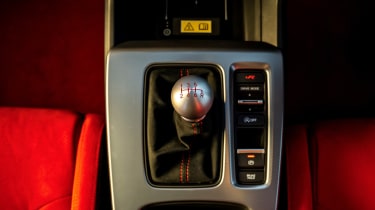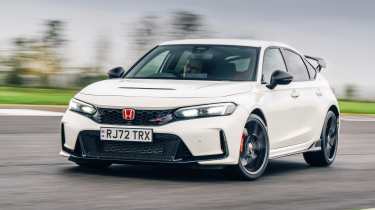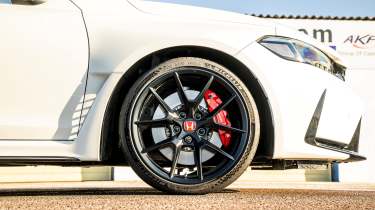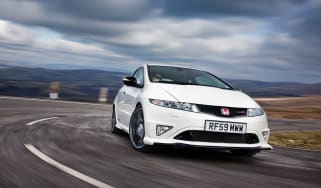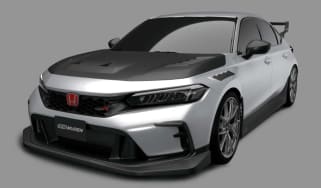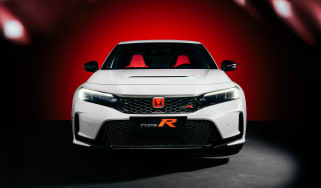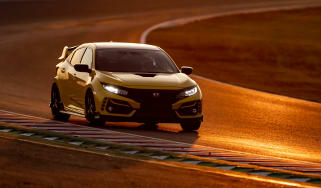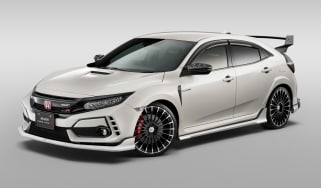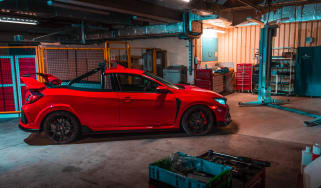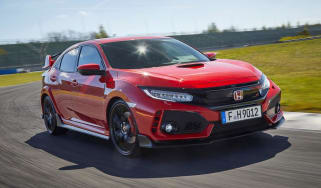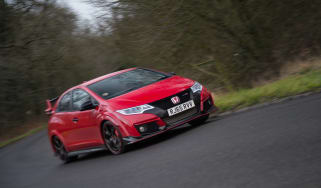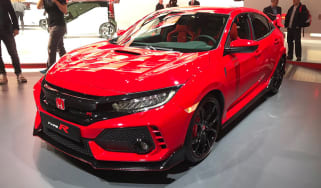Honda Civic Type R (FL5) review – the king of hot hatches doesn’t have long left
The FL5 Civic isn’t long for this world, but it goes out as the most exciting and rewarding hot hatch of modern times – perhaps ever
It's easy to be cynical about the FL5-generation Civic Type R. On paper it's very much an incremental upgrade over the previous FK8 and far from the most powerful hatch on sale, and with a more toned down design this time around, some question whether it looks extreme enough for a Type R (you can't please everyone, can you?). Then there's the small matter of the price, which at £51,905 pulls the Civic Type R into battle with some very serious metal.
In reality none of that matters, because the FL5 is astonishingly good. We'd go so far as to say that it sits right up in the pantheon of all-time hot hatchback greats. It’s beautifully honed and engineered in every sense, being more poised and exciting than a hatchback has any right to be, but that makes it all the more painful that the Type R doesn’t have long left.
European emissions legislation and the ZEV mandate is making it increasingly difficult to sell on our shores, and Honda has officially announced it’ll be pulled from showrooms in 2026. Sad, but it goes out having cemented itself as one of the performance car greats.
Engine, gearbox and technical highlights
- Wider tracks, longer wheelbase and stiffer structure than the FK8
- More power teased from the K20C1 four-pot, but still less than some hyper hatches
- Manual and front-drive only, as a Type R should be
More reviews
Compared to its predecessor, the FL5’s bodyshell is stiffer by 15 per cent thanks to extensive use of adhesives in its construction, and both wheelbase and track widths have grown by 36mm and 15mm respectively. A lesser company would have dropped all the previous-generation hardware into the new body, tweaked the motor ever so slightly to find a pinch more power and torque and left the rest alone.
Not Honda. The basic nuts and bolts might be almost entirely carry-over, but the CTR development team threw themselves into fastidiously, meticulously and relentlessly exploring ways of making everything just that little bit better.
Honda claims a weight of 1429kg, and in our independent testing found it weighed 1437kg with a full tank of fuel. This is 28kg heavier than the last FK8 we weighed, a variation Honda explains comes almost entirely from the extra adhesive and strengthening in the bodywork.
The K20C1 engine is more impressive than ever. Yes, there are useful bumps in both power and torque with peaks of 324bhp and 310lb ft (up 8bhp and 15lb ft respectively over the FK8), but it's the way in which the motor responds that makes the most significant and tangible difference. Contributing to this is an 18 per cent lighter flywheel, reducing inertia off the end of the engine by 25 per cent. Being front-wheel drive the performance figures are impressive but not eye-opening next to the Audi RS3s and Mercedes-AMG A45s of the world – 62mph in 5.4sec, 171mph flat out – but as we’ll discuss, the Civic is about so, so much more than that.
The driver mode menus are the real game-changer compared to the FK8, with a new individual mode that allows you to change the steering, suspension, engine mapping, engine noise, auto-blip function and the dial pack. Accessible through a switch on the centre console, the default mode for the Type R is Sport, with Comfort and +R modes on either side.
Driver’s note
‘It’s a different sort of Type R to the classic late-90s DC2 Integra, lacking that car’s feral top end and sonic edge. But while the FL5’s four-pot is turbocharged, it feels naturally aspirated. From low to medium revs, boost and torque build quickly but not explosively, but keep the throttle open and the delivery builds to a thrilling climax, a series of shift lights adding to the excitement.’ – Peter Tomalin, evo contributor, who tested the Honda Civic Type R on the road in the UK
Performance, ride and handling
- A stunning blend of sharpness, poise and feedback
- The best manual gearchange in the business
- Turbo engine likes to rev but lacks sonic character
From the moment you get behind the Civic Type R’s thin-rimmed, perfectly sized Alcantara-wrapped wheel you feel completely connected to the car. Both it and the weighted aluminium gearknob are wonderfully tactile, instantly instilling confidence that Honda’s absolutely got the basics right. This is backed up by the perfect driving position, low and ensconced, but with even better visibility than in the FK8 due to a more upright windscreen.
There's a freeness and energy about the CTR that's immediately inspiring, and consistent across all the major controls. Clutch and brake pedals are firm and silky, the steering perfectly weighted, laser-accurate and so nicely judged in terms of response that you nail your first apex without having to think about it.
The drivetrain has an expensive feel, at once sharp and smooth. The response of the engine is prompt, and the new turbocharger internals help get it spinning with what feels like no lag of any kind. Despite the lack of the expected turbo whoosh in the mid-range, torque really is abundant right across the engine’s operating speeds, and the Honda feels quicker even than the figures might suggest. Power builds quickly but progressively so that you can play the throttle to j-u-s-t have the front wheels breaking traction but not running away with wheelspin. Get greedy in the wet and the front diff locks up with a sudden loss of traction, spinning both front tyres, but if you're measured with the throttle it's possible to find decent drive. Just don't expect all the performance to be readily accessible no matter the weather.
On the track there's plenty of opportunity to feel for and ultimately breach the limits of grip, revealing a progressive stability and consistency that gives lots of confidence. It'll slide its tail beautifully, too, if you give it the right nudge of lock and lift off as you turn in. The brakes have great feel, strong stopping power and rarely if ever fall into ABS, even in the wet.
It's equally brilliant on the road. There isn't scope for extreme angles, but the CTR remains playful at less than lunatic speeds. That measured steering response is welcome, as is the progressive nature of the powertrain. It's also great to have more adjustability for the dynamics than the FK8 offered, the new Individual mode allowing you to mix and match chassis and powertrain settings.
The Civic is firm and can be caught out by sharp-edged bumps, causing you to pogo around in the seat, but it gets better the faster you go. In your mind’s eye you pick the lines, your hands make the inputs and you find the Civic is on the exact line you wanted, and the next, and the next. With single steering inputs you carve neatly through the turns, while adding to the sense of precision and calm is the chassis, rotating the car just so and filtering out noise from the road surface. There’s a rare and wonderful quality to its dynamics, a clean, effortless precision that genuinely does bring to mind the 911 GT3.
The Civic is a much simpler car than the GR Yaris but it’s every bit as much a product of obsession, and in a much more subtle, long-game way. The Type R team were able to influence the design of the regular Civic at its inception, building in specific strengths and engineering details they would need to deliver the Type R’s extraordinary dynamic fidelity. And deliver they most certainly have.
There was magic like this in the last Civic Type R but it feels like it has been honed and refined to an even more exceptional level, and there’s plenty more to enjoy too. Usually, if the feel of the brake pedal doesn’t draw attention to itself, it’s fine, but the Honda’s pedal stands out because it is so brilliantly judged: perfect response stepping in light or hard, terrific progression and easy modulation. And you won’t find a better gearshift anywhere, the Civic’s little silver lever snicking around the gate with a satisfying precision and ease.
Driver's note
‘In some ways the Type R stretches the definition of a hot hatch. It almost looks like a small saloon, and its low, wide stance means it’s not the kind of car you tip into corners with a back wheel in the air. But the Civic’s resolute stability, precision and sense of connection culminate in a new kind of thrill. It’s almost what you’d imagine a ’90s touring car would feel like.’ – Yousuf Ashraf, evo senior staff writer, who tested the Honda Civic Type R on the road in the UK
MPG and running costs
Honda quotes an mpg figure of 34.4mpg on the combined cycle, which we found achievable only on long motorway runs. Get the turbocharger spinning and things take a quick dive down into the 20s – on average, expect to get around 27-28mpg when using the Type R as intended.
Honda’s peerless reliability ratings do make a mockery of many European brands, which yields its greatest benefits as the cars get older and past their warranty periods. Still, as a result, running costs are expected to be low, especially when compared to rival hyperhatches from AMG and Audi.
All Type Rs run on huge (for a hot hatch) 265-section 19-inch Michelin Pilot Sport 4 S rubber that we costed at around £280 per tyre, fitted. This is an inch down on the 20-inch Continental tyre previously fitted to the FK8.
Interior and tech
If we were to write a handbook of how to design and package the perfect hot hatchback interior, it would read something like this. The Civic Type R combines an almost perfect driving position with a simple, easy-to-use interior that’s high quality, distinctive and visually interesting.
The key touch points we’ve already gone over, but they’re worth mentioning again as they’re so important. Step into the cabin and shut the door behind you, the FK8’s tinny clang is replaced by a reassuring thud. The seat is mounted low, and while it is very soft, it’s also brilliantly supportive and wrapped in about the grippiest material we’ve ever tested in a modern car. Once you’re sitting comfortably, even the Type R’s immense lateral adhesion won’t wrench you from your perfect driving position.
The steering wheel is next; it’s small without feeling toy-like, and the rim is thin, with the bare minimum of padding and only the slightest of indentations at the three- and nine-o’clock. It’s also perfectly round – a novelty these days – and finds a good balance of useful controls on the steering wheel without being excessively busy.
Behind sits a high-resolution driver display that by default will show two round dials with red background hues and yellow needles. This is a direct reference to the NSX Type R and one we can definitely get behind. Within each of the round graphics is a customisable space for any relevant information, but with a bit of fiddling you can remove these altogether. Comfort mode has a similar layout but ditches the red hues, and +R will swap these for a bar chart rev counter and much bigger speed display. Regardless of chosen mode, there is a separate set of rev-dependant LED lights that sit above.
The dash and centre console are simple, clean and well built, with no faux carbonfibre in sight. Instead the trim materials are either a textured aluminium or yet more Alcantara. The infotainment screen is perhaps a little small by modern standards, and isn’t the most sophisticated, but the screen is a good resolution and phone mirroring apps work seamlessly. Within the embedded system is a Nissan GT-R-like RLog system that will display real-time dynamic and technical performance information, too.
Perhaps the only snag is that the Type R is a strict four seater, which limits its usability compared to something like a Golf GTI.
Price and rivals
At £51,905 the Honda's pricing is punchy, but its depth of engineering and involvement are unmatched in the class. It's simply the best new hot hatch you can buy.
What's more, although it's almost 100bhp down on top-tier machines such as AMG's A45 S and Audi's RS3, the Civic's fine-graded motorsport feel makes it more exciting than much more powerful alternatives. Toyota’s GR Yaris has a similar sense of purpose but is a much less practical package, with a starkly different character. Whereas the Yaris channels the impregnable DNA of old Subaru Imprezas, the Civic Type R feels more like a Super Tourer – more lively and highly strung.
In every test we have put the Type R into, it demonstrates that the highest level of driver engagement isn’t exclusive to the exotics and the specialists. It’s a hatchback that can carry a family for mundane tasks before instantly turning its hand to being a devastatingly rewarding car for trackdays, or those drives where you simply want to get away from it all. It's a sure-fire evo icon.
Honda Civic Type R (FL5) specs
| Engine | In-line 4-cyl, 1996cc, turbocharged |
| Power | 324bhp @ 6500rpm |
| Torque | 310lb ft @ 2500-4000rpm |
| Weight | 1429kg |
| Power-to-weight | 230bhp/ton |
| 0-62mph | 5.4sec |
| Top speed | 171mph |
| Basic price | £51,905 |


